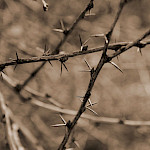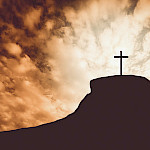The Lamb on the Throne
At the close of chapter 3 of the Book of the Revelation, the scene changes from earth to heaven. There is no more to be seen of stars or lampstands, shedding forth their lights on an earthly scene. In the opening words of chapter 4, John—as representative of the heavenly saints—hears a voice calling him up thither, no longer to hear of witnessing or failing “churches,” under reproof or exhortation as to their condition there, but to “Behold” an open door in heaven—and to hear a voice from thence calling him “to come up hither.”
This is symbolic. It is teaching us by sign and utterance, of the rapture of the heavenly saints from earth to heaven, at the coming of the Lord to the air as described in 1 Thessalonians 4:17-19 and 1 Corinthians 15:51-52. And at this point, the third section of the the Book of Revelation begins, distinguished in its opening chapter, also as in chapter 4:4 R.V., as “the things after these.” The “things which are,” as described in chapters 2 and 3—the church in its history throughout the present dispensation, having come to their end, we now enter on a view of the saints as glorified in heaven, the first of those scenes which occupy the period spoken of as “the things which shall be hereafter”—or “after these.”
And the first sight that meets the gaze of these raised and glorified saints, as symbolised in the raptured Apostle John, is “a throne set in heaven, and One seated on that throne.” For there is absolute sovereignty there. The will of God is done there perfectly. The glorified saints are represented here, first, as twenty-four crowned elders—a symbolic number representing the complete circle of the orders of the priesthood in kingdom days (1 Chr. 24:4, 18). These represent the saints of former dispensations (see Heb. 11:2)—or as some think, rather, the saints of this dispensation, crowned with Victors’ crowns and seated on thrones, clothed in white; for they have finished their warfare and are here seen at rest, calmly seated in the very presence of God. The mutterings of “thunders” and “voices,” and the flashings of lightnings from “out of” the central throne do not disturb them, for they know that their judgment is past (John 5:24), and to them there is “no condemnation” (Rom. 8:1).
But the judgments of God are soon to be let loose “on the earth,” and by them, men who have rejected grace will “learn righteousness” (Isa. 25:9). And the next view the Seer is called to look upon in this heavenly circle is that of four living creatures—not beasts as A.V.—but beings, instinct with divine and spiritual life, and intelligence, which remind us of the cherubim as described in Ezekiel 1, symbolic of the glorified saints of the redeemed of this age as associated with Christ in His glory, as the future rulers and administrators of His Kingdom, which is soon to be inaugurated. For as Hebrews 2:7 tells us, the “inhabited earth” of the future, is not to be under the government of angels, but of redeemed men.
In chapter 5, where the Throne-sitter—the eternal God—here symbolically shown in His Majesty and Might (Heb. 8:1; 12:2) is seen to have a Book of Roll, lightly lying on His right hand, fully sealed. And an angel’s loud voice is challenging all creation in the words, “Who is worthy to open the Book and to loose the seals thereof?” For He to whom the forfeited dignity lost by Adam is entrusted (Gen. 1:26-27 with Rom. 8:20-22), must be “worthy” to maintain the honour to be conferred upon Him. To this call there is no answer. No created being answers the Angel’s loud challenge. Nor is there one found who is able to “open the book,” or even to “look” thereon. And John weeps. Yes, even in that scene of unutterable glory, he weeps “much,” for the silent universe tells the insufficiency of man to fulfil the demands of a Righteous and a Perfect God.
Then one of “the elders,”—those glorified saints, who stand in the Divine counsel and know fully the resources of God, bids John dry his tears, for as of old God’s Divine mercy provided “a lamb for Himself” (Gen. 22:8) as a sacrifice, and later a king to rule His kingdom (1 Sam. 16:1), so now He has One worthy of the high and holy office of claiming the title deeds of the earth, and administering God’s rule in His kingdom, delivering the inheritance from the power of all usurpers. And the Seer is then called to “Behold” (v. 5) this worthy One, who now comes into view. He is distinguished by the elder as “The Lion of the tribe of Judah,” and the place He is said to occupy is “the midst of the throne,” surrounded by the enthroned elders and the living ones. But when John turns his eyes in the direction whence this mighty One, this Lion of Judah comes, he beholds a Lamb—the actual word is “a young Lamb”—not the symbol of majesty, but of meekness, not of strength, but of submission (Isa. 53:7), and here seen as it had been “slain”—with the memorials of Calvary still, as it were, fresh before God: “newly slain” (Heb. 10:20, Newberry).
For it is on the ground of His Sacrifice, once offered and for ever accepted by His God, sealed in His resurrection and glorification, that He is to fill the throne and to reign. “He came,” came from His place of glorification in the midst of the throne, and in His act of taking the Book from the Throne-sitter, acknowledges that God is the source of all authority, and that He alone can delegate that authority—and that He receives it directly from His hand (Dan. 7:13-14). For He would not and did not receive this power from the “god of this world” (Mt. 4:9), when He was offered it by him, nor from the fickle multitude of mankind when they wanted Him in earthly days to make Him their “king” (John 6:15). And the action of the Throne-sitter of letting the Book pass from His hand, into that of the Lamb, surely shows, that not only “all authority” (Mt. 28:18) belongs to Christ, but that all confidence as to His ability to use it aright is in the heart of God toward Him.
And what is this seven-sealed Book, but that of the Divine counsels respecting the earth, and the opening of its seals the taking possession of it by judgment, or its deliverance from the usurping power of Satan, to become the Kingdom of Christ (Rev. 11:15). For while it is by the blood of Christ that the title to earth as His inheritance is secured, it will be by the power of Christ that it is to be possessed, in order to be ruled by Him. And the acknowledgement of His title as the Lamb on the throne assures us, that His rule will be beneficent as well as righteous. Need we wonder that as the title deed to the inheritance thus passes from the hand of God to the hand of the Lamb, that the heavenly host—first the glorified saints, then the whole creation to its utmost bounds, fall down in worship before the Lamb on the throne.
And it is worthy of note that while His worthiness is universally acknowledged, and all extol Him, the song of the redeemed is more direct and personal than others, for they only sing, “Thou art worthy” (v. 9). And it is worthy of note that only the redeemed “sing.” Other circles of created beings who share in the universal chorus say with a loud voice, “Worthy is the Lamb that was slain,” while the entire creation ascribe “Blessing and honour, and glory and power” unto Him; it is the redeemed and glorified saints who sing “Thou art worthy.”
Article series: Our Glorious Lord
The Coming Lord The Patience of ChristPrevious article




